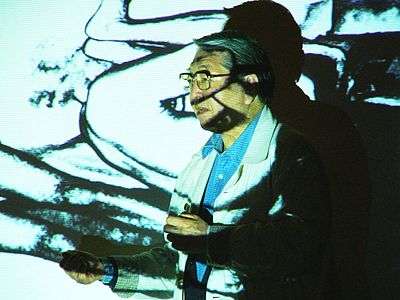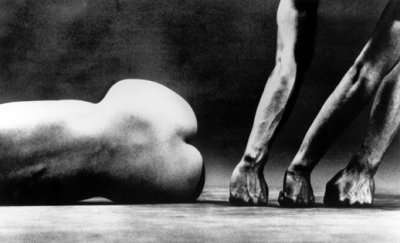Eikoh Hosoe
Eikoh Hosoe (細江 英公, Hosoe Eikō, born 18 March 1933 in Yonezawa, Yamagata)[1] is a Japanese photographer and filmmaker who emerged in the experimental arts movement of post-World War II Japan. He is known for his psychologically charged images, often exploring subjects such as death, erotic obsession, and irrationality. Through his friendships and artistic collaborations he is linked with the writer Yukio Mishima and 1960s avant-garde artists such as the dancer Tatsumi Hijikata.



Biography
At birth Hosoe's name was "Toshihiro" (敏廣); he adopted the name "Eikoh" after World War II to symbolize a new Japan.[2] While he was a student at the Tokyo College of Photography in the early 1950s, Hosoe joined "Demokrato," an avant-garde artists' group led by the artist Ei-Q.[2] In 1960, Hosoe created the Jazz Film Laboratory (Jazzu Eiga Jikken-shitsu) with Shuji Terayama, Shintaro Ishihara, and others.[3] The Jazz Film Laboratory was a multidisciplinary artistic project aimed at producing highly expressive and intense works such as Hosoe's 1960 short black and white film Navel and A-Bomb (Heso to genbaku).[3]
Eikoh Hosoe is best known for his dark, high contrast, black and white photographs of male and female bodies. Some reference religion, philosophy and mythology, while others are nearly abstract, such as Man and Woman # 24, from 1960.[4][5]
With Mishima as a model, Hosoe created a series of dark, erotic images centered on the male body, Killed by Roses or Ordeal by Roses (Bara-kei, 薔薇刑, 1961–1962).[6] The series (set in Mishima's Tokyo house) positions Mishima in melodramatic poses.[6] Mishima would follow his fantasies, eventually committing suicide by seppuku in 1970.[6]
With Hijikata as a model, Hosoe created Kamaitachi, a series of images that reference stories of a supernatural being — "sickle-toothed weasel" — that haunted the Japanese countryside of Hosoe's childhood.[6] In the photographs, Hijikata is seen as a wandering ghost mirroring the stark landscape and confronting farmers and children.[6] The Kamaitachi series was published in book form in 1969.
Hosoe has been the director of the Kiyosato Museum of Photographic Arts (Kiyosato, Yamanashi) since its opening in 1995.[3][7] He was awarded The Royal Photographic Society's Special 150th Anniversary Medal and Honorary Fellowship (HonFRPS) in recognition of a sustained, significant contribution to the art of photography.[8]
Awards
- 2002: Special Award from the Photographic Society of Japan.[9]
Bibliography
- Hosoe, Eikoh, and Yukio Mishima. Killed by roses. Tokyo: Shueisha, 1963.
- Hosoe, Eikoh. 鎌鼬 = Kamaitachi. Tokyo: Gendai Shichosha, 1969.
- Hosoe, Eikoh, Tadanori Yokoo, and Yukio Mishima. Ordeal by roses reedited. Tokyo: Shueisha, 1971.
- Hosoe, Eikoh. 薔薇刑 = Ba*ra*kei = Ordeal by roses: photographs of Yukio Mishima. New York: Aperture, 1985. ISBN 0-89381-169-6.
- Hill, Ronald J. Eikoh Hosoe. Carmel, CA: Friends of Photography, 1986. ISBN 0-933286-46-5.
- Hosoe, Eikoh. Eikoh Hosoe, meta. New York: International Center of Photography, 1991. ISBN 0-933642-16-4.
- Holborn, Mark. Eikoh Hosoe (Aperture Masters of Photography). New York: Aperture, 1999. ISBN 0-89381-824-0.
- Hosoe, Eikoh. 鎌鼬 = Kamaitachi. New York: Aperture, 2005. ISBN 1-931788-80-4. Reprint edition.
- Hosoe, Eikoh, and Kazuo Ohno. Butterfly dream. Kyoto: Seigensha, 2006. ISBN 4-86152-092-4.
- Hosoe, Eikoh. Deadly ashes: Pompeii, Auschwitz, Trinity Site, Hiroshima. Tokyo: Madosha, 2007. ISBN 978-4-89625-086-2.
- Hosoe, Eikoh. 鎌鼬 = Kamaitachi. New York: Aperture, 2009. ISBN 978-1-59711-121-8. Trade edition.
References
- Hosoe, Eikoh. Grove Dictionary of Art, 2000.
- Art2art Circulating Exhibitions. Eikoh Hosoe: ukiyo-e projections. Archived 11 August 2011[Date mismatch] at the Wayback Machine
- Hosoe Eikoh 細江英公 (interview). Ko-e magazine, no. 6, January–February 2010.
- Honolulu Museum of Art, wall label, Man and Woman # 24 by Eikoh Hosoe, accession TCM.2003.31.29
- Josef Chladek on Photobooks
- Loke, Margarett. Photography review; stories for the camera, some dark, some not. New York Times, 6 April 2001.
- Shinjo Ito Center. Photography studio. Archived 17 July 2011[Date mismatch] at the Wayback Machine
- Royal Photographic Society's Centenary Award Accessed 13 August 2012
- "Photographic Society of Japan Awards". Photographic Society of Japan. Retrieved 5 March 2015.
Further reading
- Furuta, Miyuki. Why, mother, why?. Tokyo: Kodansha, 1965. With photographs by Hosoe.
- Lifton, Betty Jean. Taka-chan and I: a dog's journey to Japan. New York: W.W. Norton, 1967. With photographs by Hosoe.
- Lifton, Betty Jean. A dog's guide to Tokyo. New York: W.W. Norton, 1969. With photographs by Hosoe.
- Lifton, Betty Jean. Return to Hiroshima. New York: Atheneum, 1970. With photographs by Hosoe.
- (in Japanese) Nihon nūdo meisakushū (日本ヌード名作集, Japanese nudes). Camera Mainichi bessatsu. Tokyo: Mainichi Shinbunsha, 1982. Pp. 185–89 show nudes by Hosoe.
- Lifton, Betty Jean. A place called Hiroshima. Tokyo: Kodansha, 1985. ISBN 0-87011-649-5. (1990 paperback edition: ISBN 0-87011-961-3.) With photographs by Hosoe.
- Holborn, Mark. Black sun: the eyes of four. Roots and innovation in Japanese photography. New York: Aperture, 1986. ISBN 0-89381-211-0. Pp. 17–32 discuss Hosoe's Kamaitachi series.
- Nihon shashin no tenkan: 1960 nendai no hyōgen (日本写真の転換:1960時代の表現) / Innovation in Japanese Photography in the 1960s. Tokyo: Tokyo Metropolitan Museum of Photography, 1991. Exhibition catalogue, text in Japanese and English. Pp. 46–55 show photographs from "Ordeal by Roses."
- Baudelaire, Charles. Flowers of evil. South Dennis, MA: 21st Editions, 2006. With photographs and an afterword by Hosoe.